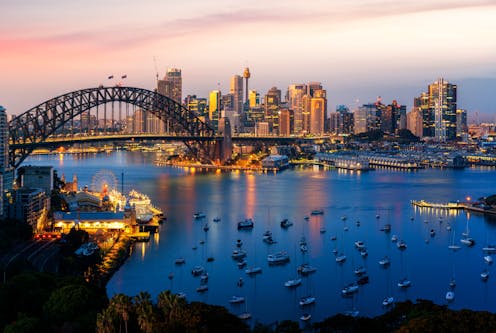The NSW treasurer says a slashed share of GST will cost his state $11.9 billion. But where did he get this figure?
- Written by The Conversation

NSW Treasurer Daniel Mookhey caught the headlines yesterday, courtesy of a blistering speech condemning the latest GST carve-up. New South Wales, he claimed, would be A$11.9 billion worse off over the next four years, leaving both the state’s coveted AAA credit rating and budget surplus in tatters.
The lost dollars, Mookhey said, could have funded 19,000 healthcare workers, 19,000 teachers or 16,000 police officers.
This is certainly a lot of revenue to lose in one hit. But it is not immediately clear where the state treasurer got this number from.
Read more: Scrap the West Australian GST deal set to cost $40 billion – leading economists
So how much less?
The new GST carve-up will see NSW receive $310 million less next year compared to this year.
But since 2021-22, Australia’s GST has been allocated under a new equalisation arrangement. We’re currently in the transition period, meaning each year states are compensated with “no worse off” payments to ensure they don’t receive less cumulative GST than they would have under the old system.
If NSW’s “no worse off” top-up payments are taken into account, the difference is only $188 million.
Mookhey could argue that the annual movement in GST payments is not the point. The issue is how much GST was factored into his budget last May. That was $1.2 billion more than what will now be received in 2024-25 under the updated distribution.
Yes, that’s a lot of money to lose, but multiplied out over four years, it’s still well short of $11.9 billion.
Short-changed on population
So, where exactly did that bigger number come from?
NSW’s beef with the GST carve-up is most likely that it receives much less than it would get if those revenues were distributed according to population share, instead of according to service delivery needs between states and territories.
Next year, for example, with 31.2% of the population, NSW will only receive 27.1% of GST revenues. In dollar terms, the difference is equivalent to about $3.6 billion, which multiplied out over four years, would come to $14.4 billion.
This is the only figure that comes anywhere near the amount suggested by the treasurer. But it’s misleading. Distributing GST by population alone ignores different service delivery needs between states.
NSW certainly copped a big drop in its assessed need relative to the average of all other jurisdictions in the latest GST update. But if history is any guide, its relative position is likely to go in the opposite direction sometime over the next four years.
The point here is we are talking about a future situation that may never arise – hardly a solid basis for a political fight.
But what’s really fair?
The treasurer’s speech gives the impression the latest GST carve-up is the source of the problem. In reality, Mookhey has taken aim at the way we try to even up the financial capacity of the states and territories. The current system of distribution allows us to ensure each Australian citizen, no matter where they live, is able to receive similar levels of government services without paying more than the average person.
For the foreseeable future, there will always be a significant gap between an ideal equal per capita distribution and what a wealthy state like NSW actually gets from the GST. That’s not because of the latest carve-up, it’s just the way it is.
The $11.9 billion GST “budget bomb” is the kind of fiction our political system could well do without. Money has not been lost, nor have jobs. They have simply been redistributed from NSW to South Australia, Tasmania, the ACT and the Northern Territory. Because of service needs, these jurisdictions receive a bigger share of GST funds than their share of the national population.
Read more: States agree to do more heavy lifting on disability, in exchange for extra health and GST funding
Spending, not income, likely the problem
What about the NSW budget’s bottom line? In the NSW Treasury’s December budget update, Mookhey estimated that next year he would deliver an operating surplus of $475 million, down from the $844 million estimated last May. Most of the slippage occurred in 2023 after the budget was brought down.
While GST revenues will be down compared to what was budgeted in 2024-25, revenues in total are well above budget, by $490 million. The problem is not revenues, but expenses, which have blown out by close to $1 billion, mainly due to the impact of rising interest rates on outstanding debt.
Any budget problems the state now faces are not only because of lower-than-expected GST revenue, but at least equally because of NSW Treasury’s failure to control expenses.
Is NSW’s credit rating on the line? Not really. One of the three big credit rating agencies has already downgraded it with little, if any, impact on the state’s borrowing costs.
Were the other two agencies to follow suit, it likely wouldn’t make a difference. As Mookhey himself recently pointed out, rating agency assessments are becoming less important than was once the case.
So why the uproar? It is all just part of an annual parade of treasurers – usually from NSW and Victoria – fronting the media and calling for a bigger slice of the national GST pie. It may also be an attempt by Mookhey to soften up the public for a credit rating downgrade, one that is ironically unlikely to matter.














